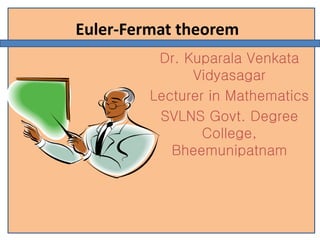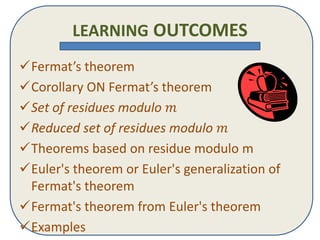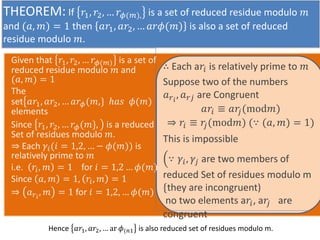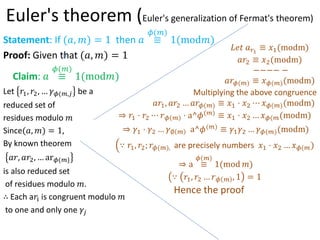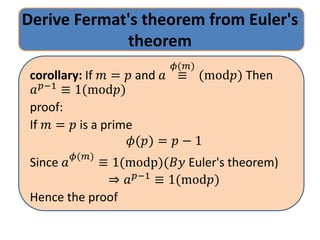Euler-Fermat theorem.pptx
- 1. Euler-Fermat theorem Dr. Kuparala Venkata Vidyasagar Lecturer in Mathematics SVLNS Govt. Degree College, Bheemunipatnam
- 2. LEARNING OUTCOMES ?FermatˇŻs theorem ?Corollary ON FermatˇŻs theorem ?Set of residues modulo ? ?Reduced set of residues modulo ? ?Theorems based on residue modulo m ?Euler's theorem or Euler's generalization of Fermat's theorem ?Fermat's theorem from Euler's theorem ?Examples
- 3. FermatˇŻs theorem Statement: If. ? is a prime and (?, ?) = 1 then ???1 ˇÔ 1 mod? proof. Given that ? is a prime and (?, ?) = 1 claim: ???1 ˇÔ 1(mod?) Since (?, ?) = 1 By known theorem When the numbers ?, 2?, 3? ˇ (? ? 1)? are derided by p, remainders are 1,2,3,ˇ.. p-1 not necessarily in this order ??? ? ˇÔ ?1(mod?) 2? ˇÔ ?2(mod?) (? ? 1)? ˇÔ ???1(mod?) But ?1, ?2; ???1 are also remainders obtained by dividing ?, 2?, ? (? ? 1)? by ? ˇŕ ?1, ?2, ? ???1 ˇÔ 1 ? 2 ? 3 ? (? ? 1) ? (1) From the above congruent relations
- 4. But ?1, ?2; ???1 are also remainders obtained by dividing ?, 2?, ? (? ? 1)? by ? ˇŕ ?1, ?2, ? ???1 ˇÔ 1 ? 2 ? 3 ? (? ? 1) ? (1) From the above congruent relations (? ? 1)! ???1 ˇÔ (? ? 1)! (modp) Since, ? is prime (?, 1) = 1, (?, 2) = 1 ˇ (?, ? ? 1) = 1 ? (?, (? ? 1)!) = 1 ??1 ˇÔ 1(mod?) Hence the proof
- 5. If ? is a prime and a is any integer then ?? ˇÔ ?(mod?) Case (i). Let (?, ?) ˇŮ 1 ? ? ¨O ? and ? ˇÔ 0 mod? ????? ?? ˇÔ 0(mod?) and 0 ˇÔ ?(mod?) By Transitive property ?? ˇÔ ? ??? ? case(ii): Let (?, ?) = 1 By Fermat's theorem ???1 ˇÔ 1(mod?) ?? ? 1 ? ˇÔ 1(mod?) ?? ˇÔ ?(mod?) Hence the proof ˇú If ? is prime and (?, ?) = 1 then ???1 ? 1 = ?(?)
- 6. Definition1.: A Set of integers ?0, ?1, ?2, ? ???1 is called a set of residues modulo ? if each ??(? = 0,1,2, ? ? ? 1) belongs to one and only one residue class modulo. Definition2.: A Set of integers ?1, ?2 ˇ , ???) is called a reduced set of residues modulo ? if exactly one of them, lies in each, residue class relatively prime to ?, Eg: {1,5} is a reduced set of residues modulo 6 = {0,1,2,3,4,5} (ˇß (1,6) = 1, (5; 6) = 1) ˇú ?(?) is the number of elements in every reduced Set of residues modulo ?.
- 7. THEOREM: If ?1, ?2, ˇ ??(?), is a set of reduced residue modulo ? and (?, ?) = 1 then ??1, ??2, ˇ ???(?) is also a set of reduced residue modulo ?. Given that ?1, ?2, ˇ ??(?) is a set of reduced residue modulo ? and (?, ?) = 1 The set ??1, ??2, ˇ ???(?,} ??? ?(?) elements Since ?1, ?2, ˇ ??(?}, is a reduced Set of residues modulo ?. ? Each ??(? = 1,2, ˇ ? ?(?)) is relatively prime to ? i.e. ??, ? = 1 for ? = 1,2 ˇ ?(?) Since ?, ? = 1, ??, ? = 1 ? ??? , ? = 1 for ? = 1,2, ˇ ?(?) ˇŕ Each a?? is relatively prime to ? Suppose two of the numbers ??? , ??? are Congruent ??? ˇÔ ?? ?(mod?) ? ?? ˇÔ ? ?(mod?) (ˇß (?, ?) = 1) This is impossible ˇß ??, ?? are two members of reduced Set of residues modulo m {they are incongruent) no two elements a??, a? ? are congruent Hence ??1, ??2, ˇ ar ?(?1 is also reduced set of residues modulo m.
- 8. Euler's theorem (Euler's generalization of Fermat's theorem) Statement: If (?, ?) = 1 then ? ˇÔ ?(?) 1(mod?) Proof: Given that (?, ?) = 1 Claim: ? ˇÔ ?(?) 1(mod?) Let ?1, ?2, ˇ ??(?,? be a reduced set of residues modulo ? Since(?, ?) = 1, By known theorem ??, ??2, ˇ ar?(?} is also reduced set of residues modulo ?. ˇŕ Each a?i is congruent modulo ? to one and only one ?? ??? ??1 ˇÔ ?1(modm) ??2 ˇÔ ?2(modm) ???? ? ???(?) ˇÔ ??(?)(modm) Multiplying the above congruence ??1, ??2 ˇ ???(?) ˇÔ ?1 ? ?2 ? ??(?)(modm) ? ?1 ? ?2 ? ?? ? ? a^?(?) ˇÔ ?1 ? ?2 ˇ ??(?(modm) ? ?1 ? ?2 ˇ ?? ? a^?(?) ˇÔ ?1?2 ˇ ??(?)(modm) ˇß ?1, ?2; ??(?), are precisely numbers ?1 ? ?2 ˇ ??(?) ? a ˇÔ ?(?) 1(mod ?) ˇß ?1, ?2 ˇ ?? ? , 1 = 1 Hence the proof
- 9. Derive Fermat's theorem from Euler's theorem corollary: If ? = ? and ? ˇÔ ?(?) (mod?) Then ???1 ˇÔ 1(mod?) proof: If ? = ? is a prime ?(?) = ? ? 1 Since ? ?(?) ˇÔ 1(modp)(?? Euler's theorem) ? ???1 ˇÔ 1(mod?) Hence the proof
- 10. Question: What is the last digit in the ordinary decimal representation of 3400 ? Solution: The last digit in the ordinary decimal representation of 3400 is the remainders when 3400 is divided by 10 By division algorithm 3400 ˇÔ 10q + ? where q, ? ˇĘ ? and 0 ? ? < 10 ˇŕ ? is the last digit such that 3400 = 10q + ? 3400 ˇÔ ?(mod10) We have to find ? such that 3400 ˇÔ ?(mod10) Since 5 is prime (3,5) = 1 By Fermat's theorem 35?1 ˇÔ 1(mod5) 34 ˇÔ 1(mod5) ? (1) Since 2 is prime and (3,2) = 1 By fermat' theorem 32?1 ˇÔ 1(mod2) 31 ˇÔ 1(mod2) 34 ˇÔ 14(mod2) ? (2) From (1) & (2) , 34 ˇÔ 1 (mod of L.C.M of 5,2 ) ) 34 ˇÔ 1(mod 10 34 100 ˇÔ 1100 (mod10) 3400 ˇÔ 1(mod10) ? = 1 Hence the last digit =1.
